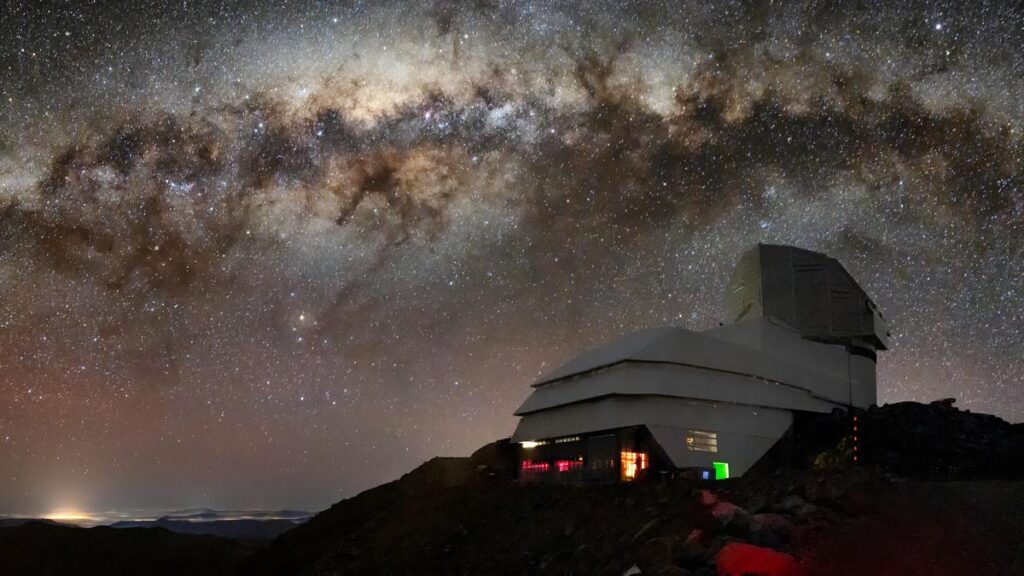Ever imagined seeing a golf ball on the surface of the moon in an image taken from the earth? This is now possible with the Vera C. Rubin Observatory (VRO), the world’s latest astronomy facility, located on one of the peaks of mountain Cerro Pachòn in northern Chile. Jointly funded by the U.S. National Science Foundation and the Department of Energy, this 8.4-metre telescope offers an unprecedented view of the universe.
The 3,200-megapixel (MP) camera installed on the VRO has 67-times more pixels than an iPhone 16 Pro camera. The large mirrors and unique design allow the telescope to capture wide-angle 3.5-degree-diameter images, equivalent to the size of seven full moons in the sky.
These unique features will allow the VRO to scan the entire southern hemisphere sky every three nights, which it will do continuously for 10 years. This ultra-high definition, wide angle survey of the sky will thus create the longest astronomical time-lapse movie of all time, allowing for many new discoveries in the solar neighbourhood and deep space alike.

Ten million alerts
While the future holds endless possibilities for this next generation observing facility, the VRO was constructed to serve four major science goals. One of them is understanding the nature of dark matter, the mysterious substance that makes up 80% of all matter in the universe.
But while dark matter can’t be seen, it causes galaxies to clump together in specific ways. Astronomers will study the distribution of galaxies near and far in order to understand the properties of dark matter, and figure out what it is made of.
Since the VRO will scan the entire southern hemisphere sky over and over again, scientists will also get a pretty good idea of how the sky looks generally. This will allow them to pick up any changes in the sky relative to images taken a few days ago, a few weeks ago, and, eventually, a few years ago.
In fact its state-of-the-art technology allows the VRO to compare each image to the ‘general’ image of that part of the sky within 60 seconds and issue an alert if any changes are detected. When fully operational, the VRO will generate around 10 million alerts from 20 TB of raw data collected every night. That’s equivalent to more than three years of streaming videos.
The changing sky
While most of the changes in the sky are due to fast-moving objects such as comets, there exist other celestial entities whose position and brightness can change over time. For instance, while 1.5 million asteroids — rocky bodies orbiting the sun between Mars and Jupiter — have been discovered, only 30% of those smaller than 140 m are known so far. The VRO is expected to increase this figure to 90% and allow scientists to locate ‘killer asteroids’, which despite their relatively small size could devastate our planet if they strike it.
With its unprecedented resolution, the VRO can raise the count of known solar system objects by 10x, discovering many new comets and asteroids, dwarf planets like Pluto, and even a ninth planet if it exists.

All galaxies interact with their neighbours gravitationally. Small satellites are torn apart by the gravity of bigger galaxies as they merge with them. The VRO will map the distribution of stars in the Milky Way, helping astronomers identify ‘streams’ of stars that once belonged to smaller galaxies that blended with the Milky Way millions of years ago.
Given its unique long-term survey capability, the VRO will also discover millions of objects of variable brightness. For instance, dying stars explode as supernovae, which brighten up for a few days before their nuclear furnace is extinguished. Some stars may have planets, or another star orbiting them, blocking their light from reaching us occasionally. Other variable stars may change in brightness because their outer surfaces pulse over a few hours to a few days.
The first images
In a June 23 press conference, the observatory revealed that the $473 million facility had already discovered 2,104 asteroids in a week of observations. All other efforts combined currently find around 20,000 asteroids a year.
While one of the initial images displays swirling clouds of dust and gas in the Trifid and Lagoon nebulae 9,000 lightyears from the earth, another shows a section of the Virgo galaxy cluster located 54 million lightyears away.
The giant images captured by the VRO are a journey through space and time: Milky Way stars shining in an array of colours from blue to red in the foreground, groups of galaxies with reddish hues moving away from us in distant space, and a suite of gravitationally interacting galaxies in a nearby cluster sandwiched in between.
The VRO is distinguished from its predecessors, including the James Webb Space Telescope: while they are more sensitive, they can only observe a small patch of the sky at a time.

Vera Rubin’s legacy
The VRO was originally proposed in 2001 and was then called the ‘Large Synoptic Survey Telescope’ (LSST). It was renamed as the Vera C. Rubin Observatory in 2019.
Rubin (1928-2016) was an American astronomer. She was the first to show that spiral galaxies rotated so fast that if their constituents were just stars, they should fly apart. The implication was that there are large amounts of unseen matter holding galaxies together, the substance we call dark matter today.
Despite her pioneering work, gender bias denied Rubin a Nobel Prize. Now, the VRO honours her and her colleagues by observing billions of galaxies as part of the ‘Legacy Survey of Space and Time’, which will help astronomers understand the nature of dark matter, whose existence first came to light in Rubin’s work.
Smriti Mahajan is an astronomer and science communicator promoting STEM education through astronomy. [email protected]
Published – July 04, 2025 12:00 pm IST

